|
Barnegat Bay is
home to several species of crabs, but the Blue
crab is the most common and sought after. |
|
Crabs
Crabs
Blue Crab
Blue Crab
Molting
Fiddler Crabs
Rock Crabs
Peekytoe
Jonah
Crab
Rock vs
Jonah
Crabs |
|
Crabs
Crustaceans |
|
Crabs are
classified in the phylum
Arthropoda. This is the same phylum as
insects and spiders, however crabs are in the
subphylum Crustacea (crustaceans) along with
shrimp, lobsters and prawn.
They are called
"decapods", meaning they have 10 legs. The front
pair is modified with strong claws and in some
species the rear pair is modified for swimming.
|
|
Blue Crab
Callinectes sapidus |
|
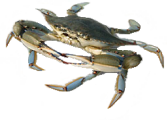 Blue
crabs are one of the most important commercial
and recreational species in New Jersey. Blue
crabs are one of the most important commercial
and recreational species in New Jersey.
Blue Crabs are
found from Nova Scotia to northern Argentina,
but are most abundant from Massachusetts on down
and around the coast to Texas.
The blue crab's abundance, beautiful coloration
(a brilliant blend of olive-green, blue and
red), aggressive temperament and delicious
flavor make it a favorite of recreational
crabbers in New Jersey
Although most small boats are ideal for reaching
crabbing areas, almost any bank, bulkhead,
bridge or pier bordering tidal waters can
provide excellent crabbing.
<click here to learn more about blue crabs> |
Black-Fingered Mud Crab
Panoeius
herbstii
|
|
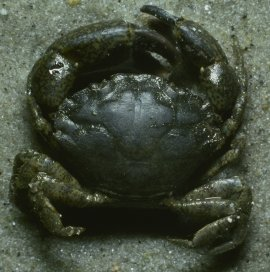 Though
little known, the black-fingered mud crab is the
most numerous of the non-swimming crabs in the
bay. Though
little known, the black-fingered mud crab is the
most numerous of the non-swimming crabs in the
bay.
These crab grow to be about an inch and a
half across its head.
The black-fingered
mud crab is a tiny, grayish-brown crab with
powerful, black-tipped claws, one bigger than
the other.
The larger claw,
called the major claw, has a large tooth on the
movable "finger" of the claw.
The mud crab's
carapace, or shell,
is wider than it is long, with five "teeth."
Like all crabs, they breathe oxygen through
gills. These crabs live completely under water,
unlike other species of semi-terrestrial crabs
such as the fiddler crab
Mud
crabs range from the salty mouth of the Bay up
to moderately brackish waters.
These mud crabs
are found on and around rocks, and around rocks,
mud flats,
pilings, oyster reefs, grass beds and sponge
colonies near the shore. They sometimes create
burrows under shells and stones.
They primarily feed on
other small invertebrates, such as worms, clams
and other crabs. They
use their strong
claws to crush the shells of young clams and
oysters, barnacles, periwinkles and other
shellfish. They will also feed on hermit crabs
by seizing a hermit crab's protruding legs and
pulling it from its shell.
<click here for more images> |
|
Fun Fact -
Black-fingered mud
crabs are commonly found living inside cans,
bottles, and other trash discarded by humans.
The debris offers the little crabs protection.
This is a
reflection of how animals have learned to adapt
to an ever-increasing human impact |
|
Green Crab
Carcinus maenas |
|
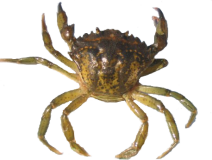 Green
crabs have dark green coloration on their
carapace with numerous darker blotches. They
possess flattened -walking legs on the last set
of segments, and not paddles (like the blue
crab). Green
crabs have dark green coloration on their
carapace with numerous darker blotches. They
possess flattened -walking legs on the last set
of segments, and not paddles (like the blue
crab).
They have more compact
claws for crushing their prey.
Mature male crabs
sometimes are yellow on their underside, while
mature females are reddish-orange.
Green crabs are an
introduced species to the area. They generally
inhabit the colder waters within the intertidal
zones of New England and south to New Jersey.
Green crabs are found in
nearshore and estuarine waters. They tend to
prefer higher salinity
waters, usually near inlets by salt marshes.
The mature males grow to
about 3 inches and females to 5 inches. They
feed on small invertebrates, including snails.
<click on
image to enlarge>
<click
here for more images> |
|
Atlantic Rock Crab
Cancer irroratus |
|
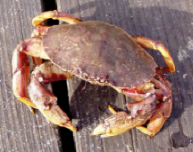 Rock crabs
like most other crabs ,
they are decapods. Rock crabs
like most other crabs ,
they are decapods.
They
live in the
benthic zone
(bottom) of the ocean and are able to adapt
to extreme variations in depth.
Rock crabs are extremely mobile
and as a scavenger, do not remain in one spot for very
long.
Each season they move
between varying depths.
In the autumn, which is
their season of reproduction, most rock crabs
remain at shallow depths. They tend to bury
themselves in rocky areas, in tide pools and
wander into lagoons.
|
|
Fun Fact -
The
rock crab has the nickname "Peekytoe" <click
here to learn more> |
|
The rock crabs are similar to Jonah
Crabs Cancer borealis. Identification is
tricky. Although Jonah crabs are larger but if
not fully grown they can be the same size as
large Rock crabs |
|
|
|
Jonah Crab
Cancer borealis |
|
|
|
Common Spider Crab
Libinia emarginata |
|
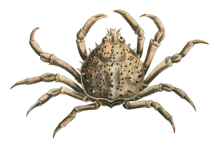 The
common spider crab is also called the Atlantic
spider crab or portly spider crab. The
shell (carapace) is spiny and covered with short
hairs. The shell grows to 4 inches in
diameter with a leg-span of twelve inches. The
common spider crab is also called the Atlantic
spider crab or portly spider crab. The
shell (carapace) is spiny and covered with short
hairs. The shell grows to 4 inches in
diameter with a leg-span of twelve inches.
Like most other crabs ,
they are decapods.
Spider Crabs appear
fearsome-looking but they are actually slow
moving and harmless to humans.
Not particularly
aggressive, the spider crab's main defense
against predators is camouflage. The
hook-like hairs on the crab's shell hold
algae and other small debris in place.
They can also burrow in soft sediment.
Spider crabs are
omnivorous scavengers with diet consisting
mainly algae and mollusks but almost anything
else available on the bay floor including
fish, sea stars, shrimp, and other crustaceans.
|
Fun Fact - different from most
walking crabs, spider crab usually walk
forward, although they are also capable
of sidelong movement.
|
|
Lady Crab
Ovalipes ocellatus |
|
The Lady Crab is a small, rounded crab with a
collection of red and purple calico spots. The
markings serve as a camouflage both to defend
against predators and to help them ambush their
primary prey, small fish.
The Lady Crab often buries itself, leaving just
its eyes and antennae exposed
|
|
Chinese Mitten Crab
Eriocheir sinensis
|
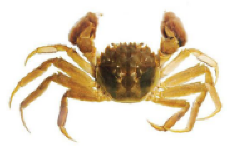
The Chinese mitten crab is
a burrowing crab whose native distribution is
the coastal rivers and estuaries of the Yellow
Sea in Korea and China.
The main identifying
features of the mitten crab are the dense
patches of hairs on the white-tipped claws of
larger juveniles and adults, hence the name
mitten crab.
The claws are equal in
size, the shell (carapace) has four spines on
either side, and reaches a width of
approximately 3 inches.
The Chinese Mitten Crab
occurs in both freshwater and saltwater. Young
crabs spend two to five years in freshwater
tributaries and can extend many miles upstream
of bays and estuaries. Mature male and female
crabs migrate downstream to mate and spawn in
saltwater estuaries. They burrow into banks
along estuaries and are able to leave the water
to walk around obstacles while migrating.
The New Jersey Division of
Fish and Wildlife is asking the Public to report
any sightings of a Chinese Mitten Crab.
Information is at the following websites:
http://www.state.nj.us/dep/fgw/news/2009/mittencrab09.htm
http://www.state.nj.us/dep/fgw/pdf/mitten_crab.pdf
<click here for more information about Chinese
Mitten Crabs> |
|
Marsh Fiddler Crab
Uca pugnax |
|
 The
American marsh fiddler crab is the smallest
fiddler crab in the Bay. Its
carapace (shell)
grows to less than an inch wide and its major
claw grows to 1.5 inches long. The
American marsh fiddler crab is the smallest
fiddler crab in the Bay. Its
carapace (shell)
grows to less than an inch wide and its major
claw grows to 1.5 inches long.
They live in salt marshes
along the bay and construct burrows that are
utilized for mating, rest and "hibernation"
during the winter.
The
burrows also serve as refuge from predators,
heat, and incoming tides.
The males are dark olive to
almost black in color with a
royal blue spot on the center of
its carapace.
Females are of similar color as
the males, but do not have the
blue spot. Either one of
the male's
chelae
(major claw) may grow until it
is half of the crabs body
weight, while the claws of the
female are the same size.
<learn more about fiddler crabs>
|
|
Fun Fact - The common English name
“Fiddler Crab” comes from the feeding of the
males, where the movement of the small claw from
the ground to its mouth resembles the motion of
a someone moving a bow across a fiddle (the
large claw). |
|
Mole Crabs
and Sand Crabs
Family: Albuneidae |
|
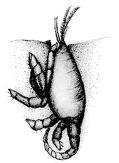 Sand
crabs and mole crabs, while not common in the
bay, are found on Island Beach and Long Beach
Island living in the turmoil of breaking waves.
They move up and down the tide line to feed in
the swash zone. The
crabs burrow backward into the sand and face
seaward, with only their eyes and first antennae
showing. Sand
crabs and mole crabs, while not common in the
bay, are found on Island Beach and Long Beach
Island living in the turmoil of breaking waves.
They move up and down the tide line to feed in
the swash zone. The
crabs burrow backward into the sand and face
seaward, with only their eyes and first antennae
showing.
As a receding wave
flows over them, the sand crabs uncoil a second
pair of featherlike antennae and sweep them
through the water to filter out tiny
plankton. |
|
Fun Fact - Sand Crabs are commonly
referred to as Mole Crabs, they are also called
Sand Fleas, Beach Fleas, Sand Bugs, and Beach
Hopper (to name a few). |
|
Atlantic Sand
Crab
Emerita
talpoida
also called
Atlantic Mole Crab |
|
 Mole
crabs are among the smallest of the crabs.
Like other crabs they has five pairs of legs,
but they do not have
pincers and move backwards rather than
walking sideways. Mole
crabs are among the smallest of the crabs.
Like other crabs they has five pairs of legs,
but they do not have
pincers and move backwards rather than
walking sideways.
They are
egg-shaped and pale grayish-tan in color. The
carapace (shell)
is convex with crosswise-creased line
immediately behind the beak and another curved
one farther back. The rear end of carapace
is smooth.
see image, top left
 The
first pair of antennae are hairy while the
second pair of antennae are long and feathery,
usually concealed under edge of carapace. The
eyestalks are long and slender.
see image, center left The
first pair of antennae are hairy while the
second pair of antennae are long and feathery,
usually concealed under edge of carapace. The
eyestalks are long and slender.
see image, center left
The first pair of
walking legs are broad and sturdy broad without
pincers. The 2nd, 3rd, and 4th pair less
sturdy and leaf-like. The fifth pair are very
slender.

Shown in the
image to the right,
the abdomen is broad in front, tapering rapidly
with a pair of forked, leaf-like appendages and
long, spearhead-shaped tailpiece on the last
segment usually bent forward underneath body.
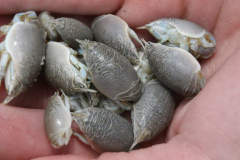
<click on any image to
enlarge>
Females grow to
about one inch, while males grow to about half
an inch.
The
lower left image
shows a handful of mole crabs with the females
being the larger specimens.
|
Ghost Crab
Ocypode quadrata |
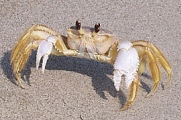
Ghost crabs belong to the Family Ocypodidae (fiddler crabs and
ghost crabs)
Adults are grayish or the color of straw, and about 2 inches wide at maturity. Like fiddler crabs, they are terrestrial and need to return to the water periodically to moisten their gills. Their compound eyes are on stalks and can swivel to give them 360° vision.
Also called sand crabs, they are mostly nocturnal being active from dusk to dawn, scouring the beach looking for anything edible.
 Ghost crabs spend most of the daytime hours in burrows. The golf ball-sized entrance holes may be visible in the dry sand of the upper beach, or in the sand dunes. The burrows extend down 3-4 feet with a "turn-around" chamber at the end. Ghost crabs spend most of the daytime hours in burrows. The golf ball-sized entrance holes may be visible in the dry sand of the upper beach, or in the sand dunes. The burrows extend down 3-4 feet with a "turn-around" chamber at the end.
They also use these burrows to hibernate in winter existing by storing oxygen in specialized sacs near their gills.
Ghost crabs return to the water for a few reasons. As mentioned above, they need to moisten their gills to breathe. Females with egg masses need enter the water to keep them moist and to release the young when they hatch.
Running into the water is also a means to escape from a predator if the burrow is not accessible.
|
|
Fun Fact - Ghost crabs are one of the
fastest crustaceans capable of running up to 10
MPH and they can run forward, backward and
sideways. |
|
Fun Fact - Like fiddler crabs, ghost
crabs have one enlarged claw. |
|
Hermit Crabs |
|
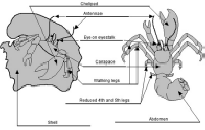 Hermit Crabs are
not true crabs, but are an intermediate form
having a soft shrimp-like tail that is protected
inside the snail shell. (like all crabs,
they are decapods) Hermit Crabs are
not true crabs, but are an intermediate form
having a soft shrimp-like tail that is protected
inside the snail shell. (like all crabs,
they are decapods)
Unlike other
crabs, the hermit crab has no
exoskeleton, so for
protection, it forces its vulnerable body into
the curved chamber of an empty
gastropod shell (or
similar object) for protection.
The four hind legs that
appear to be missing have evolved into grippers
that hold the crab inside the shell so strongly
that you will tear the animal in half before you
can extract it. The claws are usually shaped so
that together they will exactly block off the
opening when the crab retreats inside.
<click here or on image
to enlarge>
Hermit Crabs are
always on the lookout for bigger and better
shells, and when they find one they like, they
quickly switch to see if is the right fit. |
|
Fun Fact - hermit crabs can be classified
as marine hermit crabs and land hermit crabs.
Marine crabs
breathe through gills using the oxygen dissolved
in water. Land crabs have a modified gill
mechanism that absorbs oxygen from the humidity
in the air. |
|
Long-Armed Hermit
Crab Pagurus
longicarpus |
|
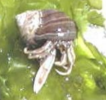 Long-armed
hermit crabs are marine crabs that inhabit the
shorelines and muddy or sandy bottoms of
Barnegat Bay They live in grass beds, from
the low-tide line to the deeper waters of the
bay. Long-armed
hermit crabs are marine crabs that inhabit the
shorelines and muddy or sandy bottoms of
Barnegat Bay They live in grass beds, from
the low-tide line to the deeper waters of the
bay.
Their bodies are
greenish-white or gray with
pincers that are
often gray with light brown stripe. The right
pincer is larger than the left and is three
times longer than it is wide. The long-clawed
hermit lives in the shells of mud snails, oyster
drills or periwinkles. The body grows to
about one inch (or less)
The long-armed
hermit crab is a scavenger which consuming
edible material from the surfaces of sand grains
and also a consumes larger pieces of
detritus
plant and animal material therefore, an
omnivore. |
|
Useful
informatin |
|
13 Fascinating Freshwater Crabs For Your
Aquarium
|


 Blue
crabs are one of the most important commercial
and recreational species in New Jersey.
Blue
crabs are one of the most important commercial
and recreational species in New Jersey.





